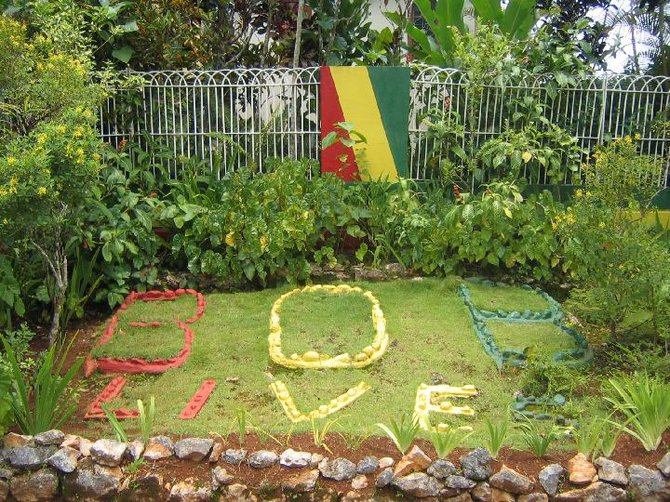 Facebook
Facebook
 X
X
 Instagram
Instagram
 TikTok
TikTok
 Youtube
Youtube

Stashed high above the brilliant turquoise waters of the Caribbean lies the small village of Nine Mile. Protected from the majority of rum-swilling tourists by a seemly impossible narrow curving road, the hamlet is home to the birthplace and final resting place of reggae legend Bob Marley.
For those with enough courage and interest to brave the journey, Nine Mile upon first sight seems little more than a few houses strewn across the landscape with little thought or planning. As you continue, you’ll come upon a poorly marked compound that houses the Bob Marley Mausoleum.
The site is surrounded by locals – a surreal lot sporting dreadlocks, Rasta hats and yellow eyes, with offers to sell you marijuana in any quantity you desire. The images conjure up a cross between Apocalypse Now and Night of the Living Dead.
Two large wooden doors mark the drive in entrance of the compound. They are opened for you, and shut immediately. Once inside, a certain feeling of safety returns and you began to feel the part of a tourist again.
You‘re directed up a set of stairs and immediately into a souvenir shop stuffed floor to ceiling with trinkets, coffee mugs, jewelry and t-shirts sporting images of the singer and/or the red, yellow and green colors of Jamaica. If you’d like to tour the Marley house and mausoleum, the charge is a hefty $18 per person. Considering the effort to get here, it’s hard to imagine anyone not continuing on.
After purchasing the ticket you climb another set of stairs and are directed through a restaurant and bar. The food is not overly priced considering the setting and surprisingly palatable. Perhaps the highlight for many would be partaking in a libation along with a spliff of marijuana without concern of consequences. For us U.S. travelers it was a bit unique.
Once suitably nourished and fortified, the tour begins. The guides are all Rasta men and provide a detailed, in-depth look at the legend’s humble beginnings, his philosophy and music. The house where he was born comprises two rooms. One a gathering room, the other a small bedroom – both totaling no more than 300 square feet. The kitchen was outdoors and consists of rocks piled in a circle to contain the open fire.
There are two mausoleums. The first entered is Mama Marley’s. The second entombs Marley as well as his half brother. Bob’s crypt is on the bottom, and his brother lies in a tomb stacked above him. It was Mama Marley’s wish that the brothers be buried together. No photography is allowed in either building.
The tour ends with a short serenade by the Rasta tour guide and encouragement to go forth with the Rastafari principles, peace and love. Perhaps that alone is worth the price of admission.


Stashed high above the brilliant turquoise waters of the Caribbean lies the small village of Nine Mile. Protected from the majority of rum-swilling tourists by a seemly impossible narrow curving road, the hamlet is home to the birthplace and final resting place of reggae legend Bob Marley.
For those with enough courage and interest to brave the journey, Nine Mile upon first sight seems little more than a few houses strewn across the landscape with little thought or planning. As you continue, you’ll come upon a poorly marked compound that houses the Bob Marley Mausoleum.
The site is surrounded by locals – a surreal lot sporting dreadlocks, Rasta hats and yellow eyes, with offers to sell you marijuana in any quantity you desire. The images conjure up a cross between Apocalypse Now and Night of the Living Dead.
Two large wooden doors mark the drive in entrance of the compound. They are opened for you, and shut immediately. Once inside, a certain feeling of safety returns and you began to feel the part of a tourist again.
You‘re directed up a set of stairs and immediately into a souvenir shop stuffed floor to ceiling with trinkets, coffee mugs, jewelry and t-shirts sporting images of the singer and/or the red, yellow and green colors of Jamaica. If you’d like to tour the Marley house and mausoleum, the charge is a hefty $18 per person. Considering the effort to get here, it’s hard to imagine anyone not continuing on.
After purchasing the ticket you climb another set of stairs and are directed through a restaurant and bar. The food is not overly priced considering the setting and surprisingly palatable. Perhaps the highlight for many would be partaking in a libation along with a spliff of marijuana without concern of consequences. For us U.S. travelers it was a bit unique.
Once suitably nourished and fortified, the tour begins. The guides are all Rasta men and provide a detailed, in-depth look at the legend’s humble beginnings, his philosophy and music. The house where he was born comprises two rooms. One a gathering room, the other a small bedroom – both totaling no more than 300 square feet. The kitchen was outdoors and consists of rocks piled in a circle to contain the open fire.
There are two mausoleums. The first entered is Mama Marley’s. The second entombs Marley as well as his half brother. Bob’s crypt is on the bottom, and his brother lies in a tomb stacked above him. It was Mama Marley’s wish that the brothers be buried together. No photography is allowed in either building.
The tour ends with a short serenade by the Rasta tour guide and encouragement to go forth with the Rastafari principles, peace and love. Perhaps that alone is worth the price of admission.
Comments